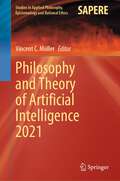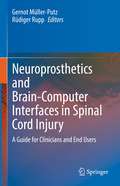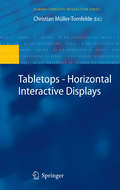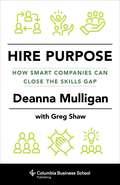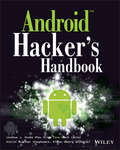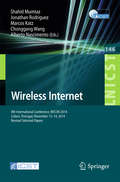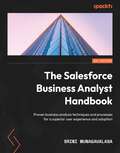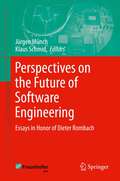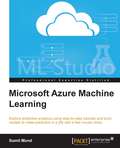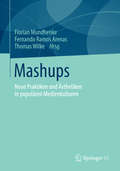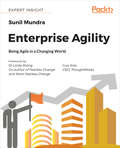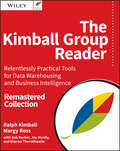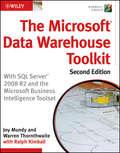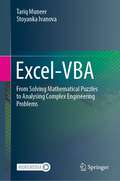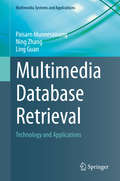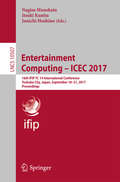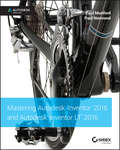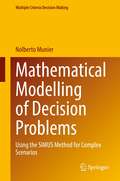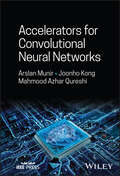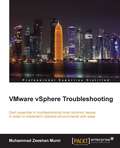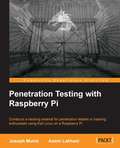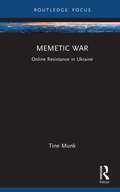- Table View
- List View
Philosophy and Theory of Artificial Intelligence 2021 (Studies in Applied Philosophy, Epistemology and Rational Ethics #63)
by Vincent C. MüllerThis book gathers contributions from the fourth edition of the Conference on "Philosophy and Theory of Artificial Intelligence" (PT-AI), held on 27-28th of September 2021 at Chalmers University of Technology, in Gothenburg, Sweden. It covers topics at the interface between philosophy, cognitive science, ethics and computing. It discusses advanced theories fostering the understanding of human cognition, human autonomy, dignity and morality, and the development of corresponding artificial cognitive structures, analyzing important aspects of the relationship between humans and AI systems, including the ethics of AI. This book offers a thought-provoking snapshot of what is currently going on, and what are the main challenges, in the multidisciplinary field of the philosophy of artificial intelligence.
Neuroprosthetics and Brain-Computer Interfaces in Spinal Cord Injury: A Guide for Clinicians and End Users
by Gernot Müller-Putz Rüdiger RuppThis book provides a comprehensive overview of the current state of the art of practical applications of neuroprosthesis based on functional electrical stimulation for restoration of motor functions lost by spinal cord injury and discusses the use of brain-computer interfaces for their control.The book covers numerous topics starting with basics about spinal cord injury, electrical stimulation, electrical brain signals and brain-computer interfaces. It continues with an overview of neuroprosthetic solutions for different purposes and non-invasive and invasive brain-computer interface implementations and presents clinical use cases and practical applications of BCIs. Finally, the authors give an outlook on cutting edge research with a high potential for clinical translation in the near future.All authors committed themselves to use easy-to-understand language and to avoid very specific information, focusing instead on the essential aspects. This makes this book an ideal choice not only for researchers and clinicians at all stages of their education interested in the topic of brain-computer interface-controlled neuroprostheses, but also for end users and their caregivers who want to inform themselves about the current technological possibilities to improve paralyzed motor functions.
Tabletops - Horizontal Interactive Displays
by Christian Müller-TomfeldeThis book is the first attempt to bring together current research findings in the domain of interactive horizontal displays. The novel compilation will integrate and summarise findings from the most important international tabletop research teams. It will provide a state-of-the art overview of this research domain and therefore allow for discussion of emerging and future directions in research and technology of interactive horizontal displays. Latest advances in interaction and software technologies and their increasing availability beyond research labs, refuels the interest in interactive horizontal displays. In the early 1990s Mark Weiser's vision of Ubiquitous Computing redefined the notion of Human Computer Interaction. Interaction was no longer considered to happen only with standard desktop computers but also with elements of their environment. This book is structured in three major areas: 'under', 'on/above' and 'around' tabletops. These areas are associated with different research disciplines such as Hardware/Software and Computer Science, Human Computer Interaction (HCI) and Computer Supported Collaborative Work (CSCW). However, the comprehensive and compelling presentation of the topic of the book results from its interdisciplinary character. The book addresses fellow researchers who are interested in this domain and practitioners considering interactive tabletops in real-world projects. It will also be a useful introduction into tabletop research that can be used for the academic curriculum.
Hire Purpose: How Smart Companies Can Close the Skills Gap
by Deanna Mulligan Greg ShawThe future of work is already here, and what this future looks like must be a pressing concern for the current generation of leaders in both the private and public sectors. In the next ten to fifteen years, rapid change in a post-pandemic world and emerging technology will revolutionize nearly every job, eliminate some, and create new forms of work that we have yet to imagine. How can we survive and thrive in the face of such drastic change?Deanna Mulligan offers a practical, broad-minded look at the effects of workplace evolution and automation and why the private sector needs to lead the charge in shaping a values-based response. With a focus on the power of education, Mulligan proposes that the solutions to workforce upheaval lie in reskilling and retraining for individuals and companies adapting to rapid change. By creating lifelong learning opportunities that break down boundaries between the classroom and the workplace, businesses can foster personal and career well-being and growth for their employees. Drawing on her own experiences, historical examples, and reports from the frontiers where these issues are unfolding, Mulligan details how business leaders can prepare for and respond to technological disruption. Providing a framework for concrete and meaningful action, Hire Purpose is an essential read about the transformations that will shape the next decade and beyond.
Android Hacker's Handbook
by Collin Mulliner Georg Wicherski Pau Oliva Fora Joshua J. Drake Zach Lanier Stephen A. RidleyThe first comprehensive guide to discovering and preventingattacks on the Android OSAs the Android operating system continues to increase its shareof the smartphone market, smartphone hacking remains a growingthreat. Written by experts who rank among the world's foremostAndroid security researchers, this book presents vulnerabilitydiscovery, analysis, and exploitation tools for the good guys.Following a detailed explanation of how the Android OS works andits overall security architecture, the authors examine howvulnerabilities can be discovered and exploits developed forvarious system components, preparing you to defend againstthem.If you are a mobile device administrator, security researcher,Android app developer, or consultant responsible for evaluatingAndroid security, you will find this guide is essential to yourtoolbox.A crack team of leading Android security researchers explainAndroid security risks, security design and architecture, rooting,fuzz testing, and vulnerability analysisCovers Android application building blocks and security as wellas debugging and auditing Android appsPrepares mobile device administrators, security researchers,Android app developers, and security consultants to defend Androidsystems against attackAndroid Hacker's Handbook is the first comprehensiveresource for IT professionals charged with smartphonesecurity.
Wireless Internet
by Shahid Mumtaz Jonathan Rodriguez Marcos Katz Chonggang Wang Alberto NascimentoThis book constitutes the thoroughly refereed post-conference proceedings of the 8th International Conference on Wireless Internet, WICON 2014, held in Lisbon, Portugal, in November 2014. The 45 revised full papers were carefully reviewed and selected from numerous submissions. The papers cover topics such as 5G mobile communications, Internet of Things (IoT), super Wi-Fi and V2V/V21.
The Salesforce Business Analyst Handbook: Proven business analysis techniques and processes for a superior user experience and adoption
by Srini MunagavalasaBecome a proficient Salesforce business analyst with the help of expert recommendations, techniques, best practices, and practical advicePurchase of the print or Kindle book includes a free eBook in the PDF format.Key FeaturesLearn the intricacies and nuances of every stage of a project's implementationDiscover real-world examples, tips, and tricks that you can apply to any Salesforce projectOvercome the challenges inherent in user interaction and improve your customer experienceBook DescriptionSalesforce business analysis skills are in high demand, and there are scant resources to satisfy this demand. This practical guide for business analysts contains all the tools, techniques, and processes needed to create business value and improve user adoption.The Salesforce Business Analyst Handbook begins with the most crucial element of any business analysis activity: identifying business requirements. You'll learn how to use tacit business analysis and Salesforce system analysis skills to rank and stack all requirements as well as get buy-in from stakeholders. Once you understand the requirements, you'll work on transforming them into working software via prototyping, mockups, and wireframing. But what good is a product if the customer cannot use it? To help you achieve that, this book will discuss various testing strategies and show you how to tailor testing scenarios that align with business requirements documents. Toward the end, you'll find out how to create easy-to-use training material for your customers and focus on post-production support – one of the most critical phases. Your customers will stay with you if you support them when they need it!By the end of this Salesforce book, you'll be able to successfully navigate every phase of a project and confidently apply your new knowledge in your own Salesforce implementations.What you will learnCreate a roadmap to deliver a set of high-level requirementsPrioritize requirements according to their business valueIdentify opportunities for improvement in process flowsCommunicate your solution design via conference room pilotsConstruct a requirements traceability matrixConduct user acceptance tests and system integration testsDevelop training artifacts so your customers can easily use your systemImplement a post-production support model to retain your customersWho this book is forThis book is for intermediate- to senior-level business analysts with a basic understanding of Salesforce CRM software or any CRM technology who want to learn proven business analysis techniques to set their business up for success.
Perspectives on the Future of Software Engineering
by Jürgen Münch Klaus SchmidThe dependence on quality software in all areas of life is what makes software engineering a key discipline for today's society. Thus, over the last few decades it has been increasingly recognized that it is particularly important to demonstrate the value of software engineering methods in real-world environments, a task which is the focus of empirical software engineering. One of the leading protagonists of this discipline worldwide is Prof. Dr. Dr. h.c. Dieter Rombach, who dedicated his entire career to empirical software engineering. For his many important contributions to the field he has received numerous awards and recognitions, including the U.S. National Science Foundation's Presidential Young Investigator Award and the Cross of the Order of Merit of the Federal Republic of Germany. He is a Fellow of both the ACM and the IEEE Computer Society. This book, published in honor of his 60th birthday, is dedicated to Dieter Rombach and his contributions to software engineering in general, as well as to empirical software engineering in particular. This book presents invited contributions from a number of the most internationally renowned software engineering researchers like Victor Basili, Barry Boehm, Manfred Broy, Carlo Ghezzi, Michael Jackson, Leon Osterweil, and, of course, by Dieter Rombach himself. Several key experts from the Fraunhofer IESE, the institute founded and led by Dieter Rombach, also contributed to the book. The contributions summarize some of the most important trends in software engineering today and outline a vision for the future of the field. The book is structured into three main parts. The first part focuses on the classical foundations of software engineering, such as notations, architecture, and processes, while the second addresses empirical software engineering in particular as the core field of Dieter Rombach's contributions. Finally, the third part discusses a broad vision for the future of software engineering.
CLEAN: CO2 Large-Scale Enhanced Gas Recovery in the Altmark Natural Gas Field - GEOTECHNOLOGIEN Science Report No. 19 (Advanced Technologies in Earth Sciences)
by Ute Münch Michael KühnThe project CLEAN (CO2 Large-Scale Enhanced Gas Recovery in the Altmark Natural Gas Field) provides site specific knowledge for a potential future pilot project. This contributed volume gives an overview and final results of the entire project which is finalized to the end of 2012.
Microsoft Azure Machine Learning
by Sumit MundThe book is intended for those who want to learn how to use Azure Machine Learning. Perhaps you already know a bit about Machine Learning, but have never used ML Studio in Azure; or perhaps you are an absolute newbie. In either case, this book will get you up-and-running quickly.
Mashups
by Florian Mundhenke Fernando Ramos Arenas Thomas WilkeMashup hat sich als Begriff eingebürgert für auditiv, visuell, audiovisuell ,,vermischte" Neuarrangements, Collagen, Bricolagen in der Musik, in Videos, in Computerspielen, in der (aktuellen Medien-)Kunst, in der Architektur. Es handelt sich um eine Verbindung heterogener Elemente, die etwas (scheinbar) Neues hervorbringen. Im Internet verbinden Websites unterschiedliche Elemente (beispielsweise Musik, Video, Hyperlinks) mit unterschiedlichen Funktionen. Ausgangspunkt für diesen Band ist die These, dass es einerseits mediale und kulturelle Techniken gibt, die diese Form des Mischgenres erst ermöglichen. Andererseits muss berücksichtigt werden, dass die mediale Kompetenz der User exponentiell angestiegen ist und weiter ansteigt. Der Band geht unter anderem der Frage nach, inwieweit es sich bei Mashups um eine qualitativ neue Form der Aneignung und/oder nur eine produktive Auseinandersetzung mit medialen Angeboten handelt.
Enterprise Agility: Being Agile in a Changing World
by Sunil MundraEnterprise Agility is practical framework for enhancing Agility and equipping your company with the tools to survive. Key Features● Prepare your company to navigate the rapidly-moving business world● Enhance Agility in every component of your organization● Build a framework that meets the unique requirements of your enterpriseBook DescriptionThe biggest challenge enterprises face today is dealing with fast-paced change in all spheres of business. Enterprise Agility shows how an enterprise can address this challenge head on and thrive in the dynamic environment. Avoiding the mechanistic construction of existing enterprises that focus on predictability and certainty, Enterprise Agility delivers practical advice for responding and adapting to the scale and accelerating pace of disruptive change in the business environment.Agility is a fundamental shift in thinking about how enterprises work to effectively deal with disruptive changes in the business environment. The core belief underlying agility is that enterprises are open and living systems. These living systems, also known as complex adaptive systems (CAS), are ideally suited to deal with change very effectively.Agility is to enterprises what health is to humans. There are some foundational principles that can be broadly applied, but the definition of healthy is very specific to each individual. Enterprise Agility takes a similar approach with regard to agility: it suggests foundational practices to improve the overall health of the body—culture, mindset, and leadership—and the health of its various organs: people, process, governance, structure, technology, and customers. The book also suggests a practical framework to create a plan to enhance agility.What you will learnDrive agility-oriented change across the enterpriseUnderstand why agility matters (more than ever) to modern enterprises Adopt and influence an Agile mindset in your teams and in your organization Understand the concept of a CAS and how to model enterprise and leadership behaviors on CAS characteristics to enhance enterprise agility Understand and convey the differences between Agile and true enterprise agility Create an enterprise-specific action plan to enhance agility Become a champion for enterprise agilityRecognize the advantages and challenges of distributed teams, and how Agile ways of working can remedy the rough spotsEnable and motivate your IT partners to adopt Agile ways of workingWho this book is forEnterprise Agility is a tool for anyone with the motivation to influence outcomes in an enterprise, who aspires to improve Agility. Readers from the following backgrounds will benefit: chief executive officer, chief information officer, people/human resource director, information technology director, head of change program, head of transformation, and Agile coach/consultant.
The Kimball Group Reader
by Joy Mundy Bob Becker Margy Ross Ralph Kimball Warren ThornthwaiteAn unparalleled collection of recommended guidelines for data warehousing and business intelligence pioneered by Ralph Kimball and his team of colleagues from the Kimball Group.Recognized and respected throughout the world as the most influential leaders in the data warehousing industry, Ralph Kimball and the Kimball Group have written articles covering more than 250 topics that define the field of data warehousing. For the first time, the Kimball Group's incomparable advice, design tips, and best practices have been gathered in this remarkable collection of articles, which spans a decade of data warehousing innovation.Each group of articles is introduced with original commentaries that explain their role in the overall lifecycle methodology developed by the Kimball Group. These practical, hands-on articles are fully updated to reflect current practices and terminology and cover the complete lifecycle--including project planning, requirements gathering, dimensional modeling, ETL, and business intelligence and analytics.This easily referenced collection is nothing less than vital if you are involved with data warehousing or business intelligence in any capacity.
The Microsoft Data Warehouse Toolkit
by Joy Mundy Warren Thornthwaite Ralph KimballBest practices and invaluable advice from world-renowned data warehouse experts In this book, leading data warehouse experts from the Kimball Group share best practices for using the upcoming "Business Intelligence release" of SQL Server, referred to as SQL Server 2008 R2. In this new edition, the authors explain how SQL Server 2008 R2 provides a collection of powerful new tools that extend the power of its BI toolset to Excel and SharePoint users and they show how to use SQL Server to build a successful data warehouse that supports the business intelligence requirements that are common to most organizations. Covering the complete suite of data warehousing and BI tools that are part of SQL Server 2008 R2, as well as Microsoft Office, the authors walk you through a full project lifecycle, including design, development, deployment and maintenance. Features more than 50 percent new and revised material that covers the rich new feature set of the SQL Server 2008 R2 release, as well as the Office 2010 release Includes brand new content that focuses on PowerPivot for Excel and SharePoint, Master Data Services, and discusses updated capabilities of SQL Server Analysis, Integration, and Reporting Services Shares detailed case examples that clearly illustrate how to best apply the techniques described in the book The accompanying Web site contains all code samples as well as the sample database used throughout the case studies The Microsoft Data Warehouse Toolkit, Second Edition provides you with the knowledge of how and when to use BI tools such as Analysis Services and Integration Services to accomplish your most essential data warehousing tasks.
Excel-VBA: From Solving Mathematical Puzzles to Analysing Complex Engineering Problems (Springerbriefs In Applied Sciences And Technology Ser.)
by Tariq Muneer Stoyanka IvanovaThis compact text is a powerful introduction to the Excel/VBA computing environment. The book presents some of the most useful features of Excel. First by introducing mathematical puzzles that will grab the reader’s attention with the reader invited to think hard on solving those puzzles. Then, solutions are presented in a logical manner. The book goes on to describe modern and up-to-date engineering problems and their solutions. Based on many years of the authors’ teaching, the book provides a practical, useful and enjoyable learning methods for readers to become expert in Excel and its application to engineering.
Multimedia Database Retrieval
by Paisarn Muneesawang Ning Zhang Ling GuanThis book explores multimedia applications that emerged from computer vision and machine learning technologies. These state-of-the-art applications include MPEG-7, interactive multimedia retrieval, multimodal fusion, annotation, and database re-ranking. The application-oriented approach maximizes reader understanding of this complex field. Established researchers explain the latest developments in multimedia database technology and offer a glimpse of future technologies. The authors emphasize the crucial role of innovation, inspiring users to develop new applications in multimedia technologies such as mobile media, large scale image and video databases, news video and film, forensic image databases and gesture databases. With a strong focus on industrial applications along with an overview of research topics, Multimedia Database Retrieval: Technology and Applications is an indispensable guide for computer scientists, engineers and practitioners involved in the development and use of multimedia systems. It also serves as a secondary text or reference for advanced-level students interested in multimedia technologies.
Entertainment Computing – ICEC 2017: 16th Ifip Tc 14 International Conference, Tsukuba City, Japan, September 18-21, 2017, Proceedings (Lecture Notes in Computer Science #10507)
by Nagisa Munekata Itsuki Kunita Junichi HoshinoThis book constitutes the refereed proceedings of the 16th International Conference on Entertainment Computing, ICEC 2017, held in Tsukuba City, Japan, in September 2017. The 16 full papers, 13 short papers, and 2 posters presented were carefully reviewed and selected from 46 submissions.
Mastering Autodesk Inventor 2016 and Autodesk Inventor LT 2016: Autodesk Official Press
by Paul Munford Paul NormandYour real-world introduction to mechanical design with Autodesk Inventor 2016 Mastering Autodesk Inventor 2016 and Autodesk Inventor LT 2016 is a complete real-world reference and tutorial for those learning this mechanical design software. With straightforward explanations and practical tutorials, this guide brings you up to speed with Inventor in the context of real-world workflows and environments. You'll begin designing right away as you become acquainted with the interface and conventions, and then move into more complex projects as you learn sketching, modeling, assemblies, weldment design, functional design, documentation, visualization, simulation and analysis, and much more. Detailed discussions are reinforced with step-by-step tutorials, and the companion website provides downloadable project files that allow you to compare your work to the pros. Whether you're teaching yourself, teaching a class, or preparing for the Inventor certification exam, this is the guide you need to quickly gain confidence and real-world ability. Inventor's 2D and 3D design features integrate with process automation tools to help manufacturers create, manage, and share data. This detailed guide shows you the ins and outs of all aspects of the program, so you can jump right in and start designing with confidence. Sketch, model, and edit parts, then use them to build assemblies Create exploded views, flat sheet metal patterns, and more Boost productivity with data exchange and visualization tools Perform simulations and stress analysis before the prototyping stage This complete reference includes topics not covered elsewhere, including large assemblies, integrating other CAD data, effective modeling by industry, effective data sharing, and more. For a comprehensive, real-world guide to Inventor from a professional perspective, Mastering Autodesk Inventor 2016 and Autodesk Inventor LT 2016 is the easy-to-follow hands-on training you've been looking for.
Regulation Fixtures in Hydronic Heating Installations: Types, Structures, Characteristics and Applications (Studies in Systems, Decision and Control #187)
by Damian Piotr MuniakThe book focuses on design and computational issues related to fixtures and armatures in hydronic heating installations, especially regulation valves, their selection, operating principles, types and construction. The analysis is complemented by connection diagrams, drawings, photos of the valves and computational examples of their selection and operation parameters when used in a pipework and a controlled object, like a radiator. It also discusses issues related to the so-called valve authority, one of the main parameters determining the quality of the valve regulation process. Further, it includes an extensive theoretical framework along with a detailed mathematical analysis and proposes new algorithms, which have been verified and confirmed experimentally. Based on this analysis, the book presents the author’s analytical approach for sizing a regulation valve, as well as an innovative design solution for a regulation valve without the limitations of the valves currently available on the market. Lastly, it introduces a new verified method of calculating the valve pre-setting. Intended for engineers dealing with heating issues, scientists and students studying environmental engineering, energetics and related fields, the book is also useful for lecturers, designers, and those operating heating installations, as well as authors of computer programs for thermal and hydraulic balancing of heating installations.
Mathematical Modelling of Decision Problems: Using the SIMUS Method for Complex Scenarios (Multiple Criteria Decision Making)
by Nolberto MunierThis book is intended as a guide to and manual on modeling complex problems in Multi Criteria Decision Making (MCDM). It encourages practitioners to consider the practicalities of real-world scenarios when modeling, while at the same time providing tips and examples of how to incorporate these realities into the initial decision matrix. The goal is to help readers build a decision matrix that replicates reality as closely as possible. Once this matrix has been constructed, the Decision Maker (DM) can select from more than a hundred MCDM methods the one that best fits the requirements and conditions of the matrix. The book features cases taken from real-world scenarios, which deal with various fields, aspects, and characteristics, and are solved using the SIMUS (Sequential Interactive Modeling for Urban Systems) method. This book is a valuable tool for practitioners, researchers and students dealing with MCDM problems.
Accelerators for Convolutional Neural Networks
by Arslan Munir Joonho Kong Mahmood Azhar QureshiAccelerators for Convolutional Neural Networks Comprehensive and thorough resource exploring different types of convolutional neural networks and complementary accelerators Accelerators for Convolutional Neural Networks provides basic deep learning knowledge and instructive content to build up convolutional neural network (CNN) accelerators for the Internet of things (IoT) and edge computing practitioners, elucidating compressive coding for CNNs, presenting a two-step lossless input feature maps compression method, discussing arithmetic coding -based lossless weights compression method and the design of an associated decoding method, describing contemporary sparse CNNs that consider sparsity in both weights and activation maps, and discussing hardware/software co-design and co-scheduling techniques that can lead to better optimization and utilization of the available hardware resources for CNN acceleration. The first part of the book provides an overview of CNNs along with the composition and parameters of different contemporary CNN models. Later chapters focus on compressive coding for CNNs and the design of dense CNN accelerators. The book also provides directions for future research and development for CNN accelerators. Other sample topics covered in Accelerators for Convolutional Neural Networks include: How to apply arithmetic coding and decoding with range scaling for lossless weight compression for 5-bit CNN weights to deploy CNNs in extremely resource-constrained systems State-of-the-art research surrounding dense CNN accelerators, which are mostly based on systolic arrays or parallel multiply-accumulate (MAC) arrays iMAC dense CNN accelerator, which combines image-to-column (im2col) and general matrix multiplication (GEMM) hardware acceleration Multi-threaded, low-cost, log-based processing element (PE) core, instances of which are stacked in a spatial grid to engender NeuroMAX dense accelerator Sparse-PE, a multi-threaded and flexible CNN PE core that exploits sparsity in both weights and activation maps, instances of which can be stacked in a spatial grid for engendering sparse CNN accelerators For researchers in AI, computer vision, computer architecture, and embedded systems, along with graduate and senior undergraduate students in related programs of study, Accelerators for Convolutional Neural Networks is an essential resource to understanding the many facets of the subject and relevant applications.
VMware vSphere Troubleshooting
by Muhammad Zeeshan MunirGain expertise in troubleshooting most common issues to implement vSphere environments with easeAbout This BookPlan, analyze, and design effective solutions for your vSphere environmentTroubleshoot problems related to vSphere performanceFamiliarize yourself with the advanced troubleshooting conceptsand become an xpert level administratorWho This Book Is ForThe books is intended for mid-level System Engineers and System Integrators who want to learn VMware power tools to troubleshoot and manage the vSphere infrastructure. Good knowledge level and understanding of virtualization is expected.What You Will LearnConfigure vSphere management assistant and troubleshooting toolsUse troubleshooting tools to monitor performance and troubleshoot different issuesLearn how to troubleshoot High Availability and other commonly known problems with clusters such as insufficient resources, failing heartbeatsUse Direct Console User Interface (DCUI) to verify configurationDiagnose storage issues including iSCSI, NFS and VMFS problemsManage vSphere Network Virtual and Distributed Switches, Trunks, VLANSMonitor and shape network traffic, configure routes and DNSQuickly resolve common day-to-day problems by analysing logs of VMware vSphere hosts and VMware vCenter ServerDebug and resolve commonly known vSphere Cluster problemsIn DetailVMware vSphere is the leading server virtualization platform with consistent management for virtual data centers. It enhances troubleshooting skills to diagnose and resolve day to day problems in your VMware vSphere infrastructure environment.This book will provide you practical hands-on knowledge of using different performance monitoring and troubleshooting tools to manage and troubleshoot the vSphere infrastructure.It begins by introducing systematic approach for troubleshooting different problems and show casing the troubleshooting techniques. You will be able to use the troubleshooting tools to monitor performance, and troubleshoot issues related to Hosts and Virtual Machines. Moving on, you will troubleshoot High Availability, storage I/O control problems, virtual LANS, and iSCSI, NFS, VMFS issues.By the end of this book, you will be able to analyze and solve advanced issues related to vShpere environment such as vcenter certificates, database problems, and different failed state errors.Style and approachA step-by-step guide full of real world scenarios that will enhance advanced knowledge, skills, and abilities to achieve competence in troubleshooting the VMware vSphere environment. Basic concepts of vSphere and the most common vSphere infrastructure problems are explained with practical solutions to resolve it.
Penetration Testing with Raspberry Pi
by Joseph Muniz Aamir LakhaniIf you are looking for a low budget, small form-factor remotely accessible hacking tool, then the concepts in this book are ideal for you. If you are a penetration tester who wants to save on travel costs by placing a low-cost node on a target network, you will save thousands by using the methods covered in this book. You do not have to be a skilled hacker or programmer to use this book. It will be beneficial to have some networking experience; however, it is not required to follow the concepts covered in this book.
Fools Rush In: Steve Case, Jerry Levin, and the Unmaking of AOL Time Warner
by Nina MunkA carefully explained business debacle.
Memetic War: Online Resistance in Ukraine (Routledge Studies in Crime and Society)
by Tine MunkMemetic War analyses memetic warfare included in cyber war and aims to develop a framework for understanding the parameters included in utilising this concept in Ukraine as a part of civic resistance.In the Ukrainian war, an informal defence tactic has developed to uphold the information flow about the war and to debunk Russia’s communications. The war has enhanced the visibility of governmental and civic activation by using the advantages of social media architecture, networks, and communication forms. The book investigates Ukraine’s public and private abilities to develop cyber capabilities to counter propaganda and dis-and-misinformation online as a defence mechanism. This book uses military ROC doctrine to understand government authorities, the armed forces, and civic engagement in the Ukrainian resistance.Memetic War will have relevance for scholars, researchers, and academics in the cybersecurity field, practitioners, governmental actors, and military and strategic personnel.
